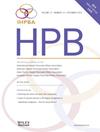肿瘤患者肝切除术后静脉血栓栓塞的相关危险因素。
IF 2.4
3区 医学
Q2 GASTROENTEROLOGY & HEPATOLOGY
引用次数: 0
摘要
背景:由于恶性肿瘤相关的高凝血病和手术炎症,肝切除术增加静脉血栓栓塞(VTE)的风险。目前的指南建议所有患者术后早期和扩大药物预防,但缺乏患者或手术因素的分层。尽管有这些指导方针,外科医生的偏好还是会影响预防措施。本研究旨在确定与肝切除术后静脉血栓栓塞相关的临床因素。方法:采用肝切除术期间出血(HeLiX)试验的数据,对肝癌肝切除术患者进行随机临床试验,单因素比较和logistic回归。结果:研究队列静脉血栓栓塞发生率为4.1%。多变量分析确定主要肝脏切除(优势比(OR) 2.59, 95%可信区间(CI) 1.38-5.03)和较高的估计失血量(EBL) (OR 1.14 / 500 mL, 95% CI 1.03-1.26)与风险增加相关。手术时间(OR 1.14 / h, 95% CI 0.95-1.34)和氨甲环酸的使用(OR 1.77, 95% CI 0.98-3.27)均无统计学意义。静脉血栓栓塞率高度依赖于切除程度(1-2节段,1.7%;3-4段,5.4%;b> 4段,6.7%)。结论:大切除和EBL增高与静脉血栓栓塞的危险性增高有关。这些患者可能需要更密集的预防措施,而不是那些有少量失血的小切除。本文章由计算机程序翻译,如有差异,请以英文原文为准。
Risk factors associated with venous thromboembolism after hepatectomy in oncology patients
Background
Liver resection increases venous thromboembolism (VTE) risk due to malignancy-related hyper-coagulopathy and surgical inflammation. Current guidelines recommend early post-operative and extended pharmacologic prophylaxis for all patients but lack stratification by patient or surgical factors. Despite these guidelines, surgeon preferences influence prophylaxis practices. This study aimed to identify clinical factors associated with VTE following liver resection.
Methods
Using data from the Hemorrhage During Liver Resection (HeLiX) trial, a randomized clinical trial of patients undergoing liver resection for cancer, univariate comparisons and logistic regression were performed.
Results
Study cohort VTE incidence was 4.1 %. Multivariable analysis identified major liver resection (odds ratio (OR) 2.59, 95 % confidence interval (CI) 1.38–5.03) and higher estimated blood loss (EBL) (OR 1.14 per 500 mL increase, 95 % CI 1.03–1.26) as associated with increased risk. Surgical duration (OR 1.14 per hour increase, 95 % CI 0.95–1.34) and use of tranexamic acid (OR 1.77, 95 % CI 0.98–3.27) did not reach statistical significance. VTE rate was highly dependent on extent of resection (1–2 segments, 1.7 %; 3–4 segments, 5.4 %; >4 segments, 6.7 %).
Conclusion
Major resection and increased EBL are associated with higher risk of VTE. These patients may warrant more intensive prophylax compared to those having minor resections with minimal blood loss.
求助全文
通过发布文献求助,成功后即可免费获取论文全文。
去求助
来源期刊

Hpb
GASTROENTEROLOGY & HEPATOLOGY-SURGERY
CiteScore
5.60
自引率
3.40%
发文量
244
审稿时长
57 days
期刊介绍:
HPB is an international forum for clinical, scientific and educational communication.
Twelve issues a year bring the reader leading articles, expert reviews, original articles, images, editorials, and reader correspondence encompassing all aspects of benign and malignant hepatobiliary disease and its management. HPB features relevant aspects of clinical and translational research and practice.
Specific areas of interest include HPB diseases encountered globally by clinical practitioners in this specialist field of gastrointestinal surgery. The journal addresses the challenges faced in the management of cancer involving the liver, biliary system and pancreas. While surgical oncology represents a large part of HPB practice, submission of manuscripts relating to liver and pancreas transplantation, the treatment of benign conditions such as acute and chronic pancreatitis, and those relating to hepatobiliary infection and inflammation are also welcomed. There will be a focus on developing a multidisciplinary approach to diagnosis and treatment with endoscopic and laparoscopic approaches, radiological interventions and surgical techniques being strongly represented. HPB welcomes submission of manuscripts in all these areas and in scientific focused research that has clear clinical relevance to HPB surgical practice.
HPB aims to help its readers - surgeons, physicians, radiologists and basic scientists - to develop their knowledge and practice. HPB will be of interest to specialists involved in the management of hepatobiliary and pancreatic disease however will also inform those working in related fields.
Abstracted and Indexed in:
MEDLINE®
EMBASE
PubMed
Science Citation Index Expanded
Academic Search (EBSCO)
HPB is owned by the International Hepato-Pancreato-Biliary Association (IHPBA) and is also the official Journal of the American Hepato-Pancreato-Biliary Association (AHPBA), the Asian-Pacific Hepato Pancreatic Biliary Association (A-PHPBA) and the European-African Hepato-Pancreatic Biliary Association (E-AHPBA).
 求助内容:
求助内容: 应助结果提醒方式:
应助结果提醒方式:


